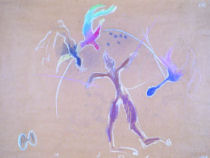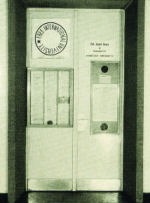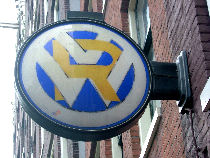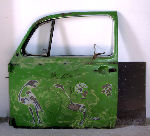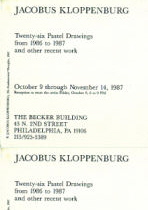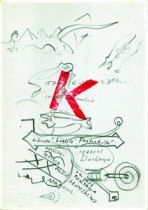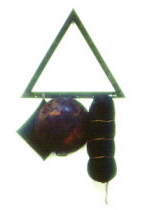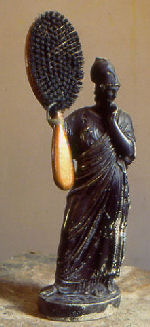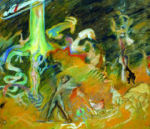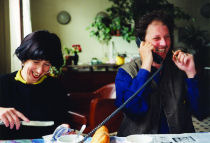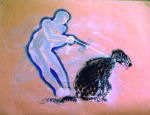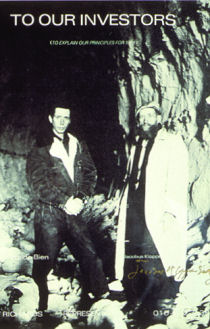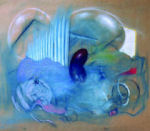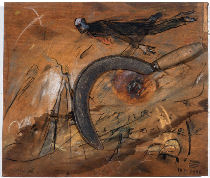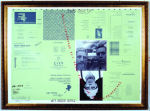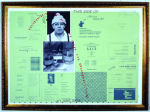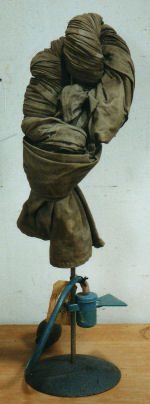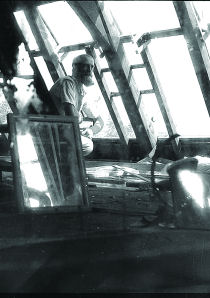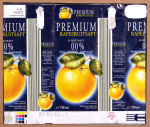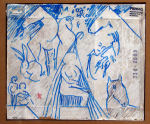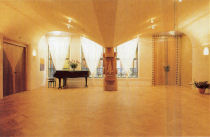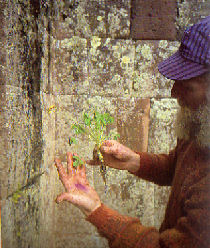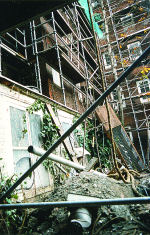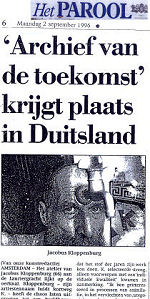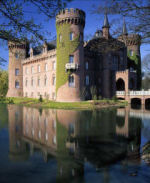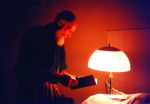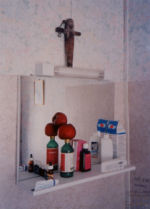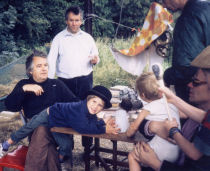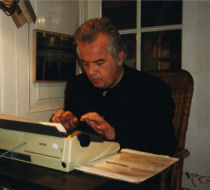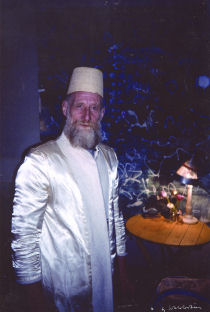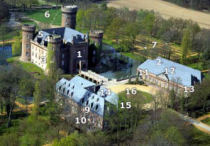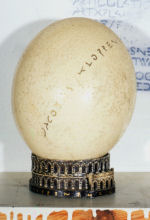|
|
<<< Previous Page - 1 - 2 - 3 - 4 - Next Page >>> 1985, December: Accompanies Waldo Bien during his work on the sculpture "Death Room Interior" in the coal mine Fürst Leopold Wulfen, Dorsten, BRD. K produces chalk drawings on the layers of coal in the mine shafts (early animal studies) and frottage (F.I.U.archive). (See Waldo Bien, by Patrick Healy, Wienand Verlag, Köln, 2000. same time Bien shows the work "Thirty-two studies for Grey" in the window of the gallery, which is related to a game of chess Duchamp played with Michel Strasbourg on the 4th of Sept. 1924. For this occasion Virgil Grotfeldt is flown in from Houston. Acquaintance with David Lebe and his "light drawings" (FIUW1986, January 23: Joseph Beuys dies in Düsseldorf. In the same year the photographer Oscar van Alphen makes photographs of Kloppenburg and The Archive as part of an assignment of the City of Amsterdam (portraits of Amsterdam Artists and their ateliers). 1986, 4th of January: NRC HANDELSBLAD, by Bas Roodnat: ‘FINALLY, AFTER 15 YEARS OF BKR, AN EXHIBITION’, "IF ANYTHlNG COULD PLEA FOR A WELL FUNCTIONING BKR IT MUST BE THIS EXHIBITION. It is magnificent work... A reality he perceives in a sort of trance, when dreams are dreamt and drawings are made during the silent nocturnal hours. It took a long time for him to master this technique of "self-elimination", so that the richness of beings that populate Kloppenburg's unconsciousness could take their places on the brown wrapping paper, unhampered by his "physical resistance". Something of Kloppenburg's working environment takes shape in the hall in FODOR, where some of his belongings are standing and lying on the floor. A cupboard with sixty drawers, out of which grow the horns of a cow. On top of the cupboard an old clock, a bunch of bananas, a hatbox, the skeleton of what looks like a cat (hare, red.). On the wall some pastel sketches and a weathered school plate with animals from Australia. There is a worn out easy chair covered with the Dutch flag. Furthermore; cardboard boxes, a flannel blanket, trays with hundreds of pieces of crayon, a bunch of branches and lots more... At night over all this shines the light of a lantern or the moon which creates an ambience in which the fantasy creatures like to appear... IT IS MAGNIFICENT WORK!" 1986, Friday the 7th of February, 20:00h: Kunstakademie Düsseldorf, RAUM 3, the F.I.U. office in the atelier of Joseph Beuys; Beuys-class meeting. Present from Holland: Bien, Kloppenburg, P. Heynen and Liesbeth Takken. Liesbeth Takken will write about this in the magazine DRIEGONAAL (Impression), spring 1986, illustrated with two pastels by K and Bien's 'Death Room Interior'. ..."While the Kunstakademie is open to the public for another yearly "Rundgang", open classrooms with works of students, one door remains closed; In RAUM 3, the atelier of Joseph Beuys, many ex-students have gathered. The provocation that has to do with the work of Beuys has led to the 'Erweiterte Kunstbegriff' (the extended conception of art), and this has not come to an end. His death calls for more: the foundation of the FREE INTERNATIONAL UNIVERSITY (for creativity and interdisciplinary research), clearly bearing the stamp of his personality, is now in need of an actual continuation... It appears from the meeting that (so far) no corresponding concept has been found as an answer to these questions, which is not strange considering the fact that only few have caught on to the social impulse of Beuys and pass it on."... 1986, 3rd of June - 5th of July : Solo exhibition in Gallery d'Theeboom Amsterdam, with large number of pastel drawings. 1986, October: Exhibition "Fifteen Contemporary Artists from the Netherlands", IMF International Monetary Fund Art Society, Washington D.C. USA (Catalogue with introduction by John Hallmark Neff). Previous to this, the exhibition was shown in castle Rhoon, NL. K's participation consists mainly of large pastels. Bien contributes his sculpture "The BANK". The exhibition is curated and organised by Cathy Hemmer. NOTE: It is through this exhibition that Bien and Kloppenburg get to know the work of Virgil Grotfeldt from Houston, TX, and vice versa. This is the start of the collaboration with American artists on multiple F.I.U. projects. 1986, VENICE: K accompanies Bien to Venice in connection with the presentation of Espace 251 Nord during the Venice Biennale <Portraits de scene a l'ile aux phoques>, Casa Frollo, in which Bien participates with two works. Acquaintance and friendship with Luk Darras, the Belgian Cultural Attaché in Rome, and his wife Barbara, with Laurent Jacob, René Depres, Johan Muyle and many other Belgian and French artists with whom Espace 251 Nord, Liège collaborates, and with the American writer Peter Noon and the art critic Eric Amouroux. A mummified cat, found by K in Venice on the cemetery Santa Clemente and carried around through the city in a plastic bag together with an olivebread, wineglasses and cigarettes, etc., is x-rayed by customs later on the way back which causes consternation. Bien incorporates the x-ray picture in the work "CASSATA". Furthermore: Photosequences by K of "Venetian Water-Runes" (pictures of water reflections in the Canal Grande). There is also a work session of three days (two nights) in the caves of the sunmountain in Maastricht, during which the nuclear reactor of Tjernobil explodes in the world "outside" and causes the first large-scale nuclear accident (New Age). Bien, Kloppenburg, Eliane Gomperts and Pieter Heyen are working inside (section A wall) on a series of bass reliefs in the walls of the marl caves; RIJKSKUNSTDEPOT.( During the war the caves where used for national art storage) Kloppenburg creates an ATLANTIS relief. Publication with black and white photos (by EG and WB), category A nuclear-free, edition 100, 3rd of May 1986, FIUadam. 1986, 18th of October: article in NRC HANDELSBLAD, by Garth Seilbing; Jacobus Kloppenburg "THE DEATH OF YOUR MOTHER IS THE DEFINITE ABNABELUNG (cutting of the umbilical cord) ", with a picture of K (on roof of Archive) and a picture of mother... on account of her death... "For years my mother was the only one who knew that I made these drawings... She judged my drawings in a completely independent manner." Did she not mind him working until deep in the night? ..."She didn't particularly like it. When she had gone to bed I would darken the window of the atelier so she was unable to see whether I was still working. I would lay some rolled up blankets in my bed, and in the morning when one of my friends came over she would say; "Kok is still sleeping". Sometimes it was terribly difficult to get into bed without being seen. But there were also periods that I worked for days in a row. She would call me from the garden then and put my food in a bucket which I would hoist with the use of a rope... One day I had found a sack full of rags on the Waterlooplein. I took it home and spread them on the floor to show what fascinated me. She understood, but I left those rags lying there while she was trying to create order from chaos. Agatha Kiljan was her name, a powerful name, with all those i's and a's."
|
|
|
|
||
|
|
|
|
|
|
||
|
|
|
|
|
|
|
|
|
|



